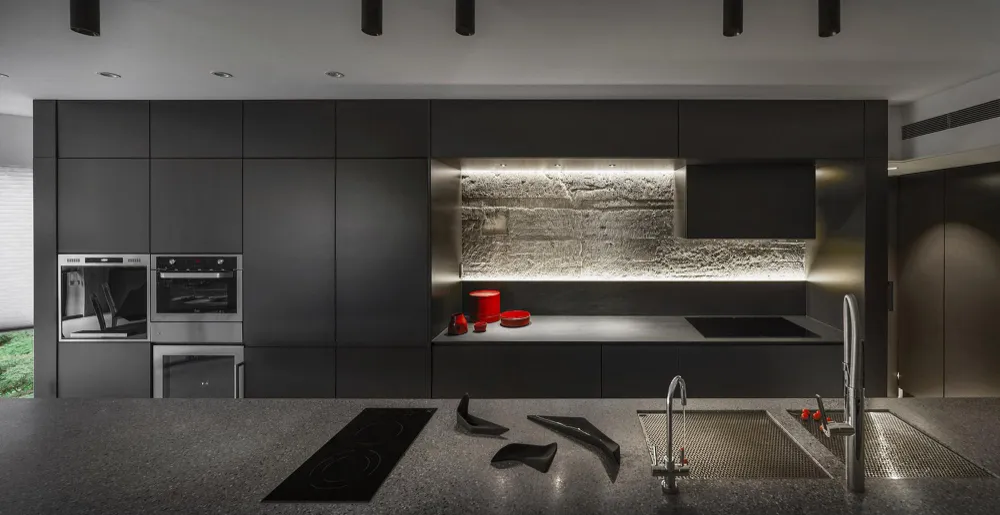

Modern kitchen design
Modern Kitchen Design: Where Elegance Meets Efficiency
The kitchen is one of the most important spaces in any home. It’s not just a place for preparing meals—it’s a hub for family gatherings, entertaining friends, and enjoying comfort and creativity.
Over the years, kitchen design has evolved to incorporate advanced technologies, innovative materials, and smart layouts. The result? Sleek, modern kitchens that blend aesthetics with functionality. In this article, we explore the key elements that define modern kitchen design and how to strike the perfect balance between style and efficiency.
9 Key Elements for Stylish and Efficient Modern Kitchens
1. Simplicity and Organization
One of the hallmarks of modern kitchen design is minimalism. Designers lean toward clean, flat lines and avoid excessive decorative details that can feel cluttered. This streamlined approach creates a sense of openness and order.
Neutral colors—like white, gray, or black—are dominant in modern kitchens, promoting a calm and balanced atmosphere. These tones can be complemented with warm touches such as wood accents or metallic finishes for added depth.
2. Innovative Use of Space
Modern homes often feature open floor plans, and kitchens are no exception. Contemporary kitchen layouts prioritize fluidity and integration with other spaces, such as living and dining areas. This creates better movement and encourages social interaction.
A popular example is the kitchen island layout, which offers extra space for meal prep, casual dining, or even family gatherings—all while keeping the area visually open and functional.
3. Smart Kitchen Technology
Smart technology is a growing trend in modern kitchen design. Homeowners can now control appliances—like ovens, refrigerators, and dishwashers—through mobile apps or voice assistants.
Smart kitchen devices offer energy efficiency, reduce cooking time, and deliver better results. Examples include ovens that automatically adjust temperature based on food type and freezers that optimize storage using advanced cooling technologies.
4. Modern Materials
Materials play a crucial role in the aesthetic and durability of a modern kitchen. Traditional surfaces like wood and marble are often replaced with innovative options like quartz, glass, or stainless steel.
These materials are known for their durability and easy maintenance—perfect for high-traffic kitchen environments. Plus, glass and metal finishes reflect light and give the space a sleek, modern shine.
5. Smart Storage Solutions
Storage can be a challenge in sleek kitchen designs. To address this, modern kitchens incorporate intelligent storage systems like pull-out shelves, sensor-activated cabinets, and hidden drawers.
Dedicated storage areas for appliances—such as blenders and pans—help reduce countertop clutter and maintain a clean, organized space.
6. Modern Kitchen Lighting
Lighting is essential not just for functionality but also for ambiance. In modern kitchens, lighting is used to create mood, enhance visibility, and elevate design.
Built-in cabinet lights and under-counter LEDs provide extra illumination without disrupting the sleek design. Soft or dim lighting can create a cozy evening atmosphere, while bright, direct lighting is perfect for meal prep and cooking.
7. Sustainability and Eco-Friendly Design
As environmental awareness grows, sustainable kitchen design is on the rise. Designers favor recycled materials and energy-saving technologies like LED lighting and low-energy appliances.
Water-saving faucets are another smart addition, reducing water usage without sacrificing performance.
8. Personalized Touches
While modern design embraces minimalism, personal touches can bring warmth and character to the space. Thoughtful details like houseplants, small artworks, or unique furniture choices make the kitchen feel inviting and uniquely yours.
These elements reflect the homeowner’s taste while maintaining the clean, modern vibe.
9. Mixing Design Styles
Modern doesn’t mean one-size-fits-all. A major trend in 2024 is blending design styles—for example, combining rustic or traditional elements with sleek modern finishes to create a unique, eclectic look.
This might involve pairing natural wood textures with minimalist countertops, or using modern lighting to accent vintage fixtures. The key is choosing materials and colors that harmonize with the rest of the home.
Conclusion
Modern kitchen design goes beyond aesthetics—it’s about creating a space that’s both beautiful and functional. With the right blend of simplicity, smart technology, innovative materials, and thoughtful storage, today’s kitchens are efficient hubs for daily life and social connection.
As lifestyles continue to evolve, so will the modern kitchen—adapting to our needs and remaining the heart of the contemporary home.
Sources:
